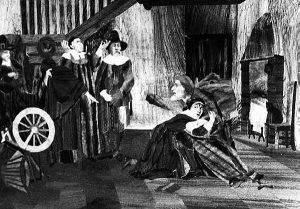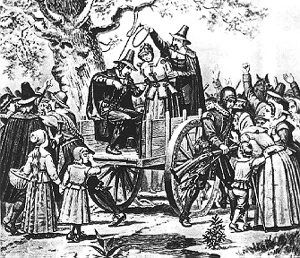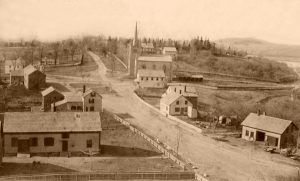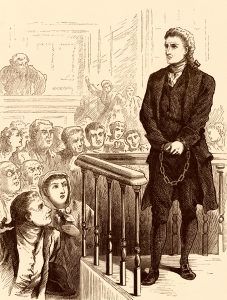Witches of Salem: Index A B C D E F-G H I-J K-N O-P Q-S T U-Z
Abigail Wheeler Barker (1656-1743) – From Andover, Massachusetts, Abigail was accused of witchcraft and imprisoned. Abigail was born to David and Sarah Wise Wheeler in 1656. She grew up to marry Ebenezer Barker, also of Andover. Abigail’s sister was Lydia Wheeler Eames, who married Daniel Eames. By the early part of August 1692, Abigail’s brother-in-law, Daniel Eames, and his mother, Rebecca Blake Eames, both found themselves in prison accused of witchcraft. On August 29, 1692, Ebenezer’s brother, William Barker Sr., and his niece, Mary Barker, were also imprisoned for witchcraft. Three days later, Ebenezer’s nephew, William Barker, Jr, was also arrested on September 1st.
On September 7th, the Reverend Thomas Barnard conducted what was known as a “Touch Test” in the Andover Church. In this ludicrous exercise, those who were accused of witchcraft were blindfolded and forced to touch the “afflicted” girls, which could identify them as a witch. With such evidence, Abigail Barker was arrested. Her husband, Ebenezer Barker, quickly joined the newly formed Andover resistance and was a signer of petitions of October 12, October 18, and December 6 sent to the governor and the high court. Despite the petition, the grand jury at the Superior Court of Judicature indicted Abigail. However, in a trial by jury on January 6, 1693, she was found not guilty. She was released, having been imprisoned for 18 weeks in Salem. Afterward, Abigail went back to her life in Andover. She was 87 years old when she died there in 1743.
Mary Barker (1679-1752) – From Andover, Massachusetts, 13-year-old Mary Barker was accused of being a witch and imprisoned. On August 25, 1692, a complaint was filed by Samuel Martin and Moses Tyler against her, her uncle, William Barker Sr., and Mary Osgood Marston for afflicting Abigail Martin, Jr., Rose Foster, and Martha Sprague. Four days later, on August 29th, Constable Epharaim Foster traveled to Andover and arrested the three accused. The daughter of an Andover church deacon, Mary felt confident that she would be freed after questioning. However, though she initially denied the charges, she soon confessed and blamed Goodwives Faulkner and Johnson for forcing her to sign the Devil’s book. She then began to demonstrate hysterical symptoms. She was placed in prison but was later found not guilty.
William Barker, Jr. (1678-1745) – From Andover, Massachusetts, 14-year-old William, Jr. was accused of witchcraft and imprisoned. During that frightening summer of 1692, two of his family members had already been accused and jailed. His first cousin, 13-year-old Mary Barker, and his father, William Barker Sr., had been arrested in August. On September 1st, Constable Epharaim Foster arrested 14-year-old William and the Reverend Francis Dane’s grandson, Stephen Johnson, whose mother, sisters, and aunt were already in prison. Examined the same day he was arrested, he, like his father, William Barker, Sr., confessed. He said that he had so recently converted to witchcraft that he had only been in the snare of the Devil for six days. During his examination, he also accused Goody Parker. Though there were several Parker women in the area, the court magistrates took it upon themselves to issue a warrant for the arrest of Mary Ayer Parker without making sure they had the right woman in custody. Unfortunately, Mary Ayer Parker would be hanged just weeks later on September 22, 1692. William Barker, Jr. remained imprisoned until he was released on bail in January 1693. He was tried the following May in Ipswich and was acquitted. He lived until January 16, 1745, dying at the age of 67.
William Barker, Sr. (1646?-1718) – From Andover, Massachusetts, William Barker, Sr. was accused of witchcraft and imprisoned but managed to escape. On August 25, 1692, a complaint was filed by Samuel Martin and Moses Tyler against William and his nieces, Mary Barker and Goodwife Mary Marston, for afflicting Abigail Martin, Jr., Rose Foster, and Martha Sprague. Four days later, on August 29th, Constable Epharaim Foster traveled to Andover and arrested the three accused. Barker was examined the same day and confessed to having been in the snare of the devil for three years. He described the devil as looking like a black man with a cloven foot. He stated that the Devil promised to pay all of his debts if he would give him his body and soul. He continued by confessing to having afflicted his accusers, accusing the Reverend George Burroughs of being the ringleader of the witches and saying that Goody Howe was also a witch. William Barker, Sr. was imprisoned, but somewhere along the line, he was able to escape. Obviously, at some point, he returned to Andover, where he lived out his life and died in 1718 at the age of 73.
Sarah Hood Bassett (1676-17??) – The sister-in-law of accused witch Elizabeth Bassett Proctor, Sarah would be indicted and imprisoned. She would take her 22-month-old daughter and deliver another child while in jail. She was later released. See more HERE.
Bridget Playfer Bishop (1632?-1692) – The first person to be executed during the Salem witchcraft trials, Bridget Playfer was born about 1632 in England. She was married for the first time in 1660 to Samuel Wesselbe in Norwich, Norfolk, England, and the couple immigrated to America. After he died, she married Thomas Oliver in 1666. When he died, she was accused of bewitching him to death but was acquitted for lack of evidence. She married Edward Bishop for the third time in about 1687. Described as a feisty, fun-loving, lusty innkeeper who couldn’t seem to keep herself out of trouble, she may have been accused of these very reasons. She was said to have owned one or more taverns, played shuffleboard, was outspoken, and dressed in provocative clothing – particularly red clothing that suggested sexual prowess. She was accused of bewitching five young women, Abigail Williams, Ann Putnam Jr., Mercy Lewis, Mary Walcott, and Elizabeth Hubbard. During her trial, several men provided damaging testimony, including one who said that many people in town considered her a witch, and another man accused her of bewitching his child and also of striking his son with a spade. John and William Bly, father and son, testified about finding poppets (voodoo dolls) in Bishop’s house and also about their pig that appeared to be bewitched or poisoned after a dispute with Bishop. There were also allegations that Bishop’s specter appeared in the rooms of several men while they slept and attacked them. During her examination, she allegedly made several conflicting statements and had a spiteful attitude, which made the case against her even stronger. In the end, she was found guilty and hanged on June 10, 1692.
Edward Bishop, Jr. (April 23, 1648?-??) – Married to Sarah Wildes Bishop, the couple had as many as 12 children. He was the son of the husband of Bridget Playfer Bishop, who would be found guilty and hanged on June 10, 1692. Said to have been tavern keepers, both he and his wife were accused of witchcraft and were arrested on April 21, 1692, along with Sarah’s stepmother, Sarah Wildes; William and Deliverance Hobbs, Nehemiah Abbott Jr., Mary Eastey, Mary Black and Mary English. The couple were examined by Magistrates Jonathan Corwin and John Hathorne the next day and were found to have committed witchcraft against Ann Putnam Jr., Mercy Lewis, and Abigail Williams. They were indicted and transferred to the Boston jail to await trial. In the meantime, Sarah’s stepmother, Sarah Wildes, was executed for witchcraft on July 19, 1692. The couple was able to escape in October 1692. After their escape, their property was seized. What happened to them afterward is unknown, but their son, Samuel Bishop, recovered some of their property. Ironically, another son, Edward Bishop III, eventually married Susannah Putnam, who was a relation of the Putnam family, who were the main accusers in the witchcraft hysteria.
Sarah Wildes Bishop (1651?-??) – Married to Edward Bishop, Jr., the couple had as many as 12 children. She was the step-daughter of Sarah Wildes, who would be executed for witchcraft. He was the stepson of Bridget Playfer Bishop, who was also found guilty of witchcraft and hanged. Sarah and her husband were also accused of witchcraft and were arrested on April 21, 1692, along with Sarah’s stepmother, Sarah Wildes; William and Deliverance Hobbs, Nehemiah Abbott Jr., Mary Eastey, Mary Black, and Mary English. The couple were examined by Magistrates Jonathan Corwin and John Hathorne the next day and were found to have committed witchcraft against Ann Putnam Jr., Mercy Lewis, and Abigail Williams. Also testifying against Sarah were Elizabeth Balch, wife of Benjamin Balch Jr., and her sister, Abigail Walden, claiming they heard Edward accuse Elizabeth of entertaining Satan at night. Both Edward and Sarah were indicted and transferred to the Boston jail to await trial. In the meantime, Sarah’s stepmother, Sarah Wildes, was executed for witchcraft on July 19, 1692. The couple was able to escape in October 1692. After their escape, their property was seized. What happened to them afterward is unknown, but their son, Samuel Bishop, recovered some of their property. Ironically, another son, Edward Bishop III, eventually married Susannah Putnam, who was a relation of the Putnam family, who were the main accusers in the witchcraft hysteria.
Katerina Biss – Nothing is known of her other than she was accused of witchcraft but not indicted.
Mary Black – An African-American slave of elderly Lieutenant Nathaniel Putman of Salem Village, Mary was accused of witchcraft on April 21, 1692. Putnam was a respected leader and member of Salem village whose younger nephews and cousins were avid witchcraft accusers. The Reverend Samuel Parris requested her examination. At her examination, held on April 22, she was accused by several of the “afflicted girls,” including Mary Walcott, Abigail Williams, and Mercy Lewis. Though she was pressed to admit that she was a witch, she steadfastly refused, stating, “I hurt nobody. Who doth? I do not know.” She was indicted and imprisoned but not tried. She was cleared by proclamation on January 11, 1693. Her owner, Nathaniel Putnam, paid her jail fees and took her back to his house.
Mary Perkins Bradbury (1615-1700) – One of the lucky ones, Mary Bradbury, was tried for witchcraft, convicted, and sentenced to be executed. Born to John and Judith Gater Perkins at Hilmorton, England, she was baptized on September 3, 1615. Her family immigrated to America in 1631, and she married Thomas Bradbury of Salisbury, Massachusetts, in 1636, one of the most distinguished citizens of the community. Years later, during the Salem witch fury, Mary would find herself in the midst of it when a merchant, Samuel Endicott, accused her of selling bewitched butter to one of his sea captains and causing dire effects on the voyage. She was also accused of assuming animal forms and suddenly “appearing” in strange places on the ships while they were at sea. Though over a hundred of her neighbors and townspeople testified on her behalf, it was to no avail, and she was found guilty of practicing magic and sentenced to be executed in 1692. Through the ongoing efforts of her friends, her execution was delayed. After the witch’s fury had died down, she was released. Some accounts suggest a jailer was bribed, and she was allowed to escape. Afterward, she and her husband went to Maine, only returning once the witch hysteria had completely died down. She died of natural causes in 1700.
Ann Wood Bradstreet – Ann was the wife of Colonel Dudley Bradstreet, who was serving as the Justice of Peace in Andover during the witch hysteria. Though Dudley Bradstreet didn’t believe the witchcraft delusion, his duties required him to issue almost 50 arrest warrants before he finally refused to issue any more. Afterward, both Dudley and his wife, Ann, were also accused. They temporarily fled the area, evading arrest.
Colonel Dudley Bradstreet (1648-1702) – Born in Andover, Massachusetts, to Simon and Ann Dudley Bradstreet, he grew up to marry Ann Wood, also of Andover, on November 12, 1673. His father, Simon, would serve as the Colonial Governor of the Massachusetts Bay Colony from 1670 to 1686. He was an attorney, a colonel in the militia, a schoolteacher, and served as a selectman and town clerk in Andover. He would also serve as a Deputy to the General Court of Massachusetts and, later, was a member of the Governor’s Council. Though he opposed the entire witchcraft delusion, he found himself in the unenviable position of Justice of the Peace in Andover during the hysteria. In the eight weeks from July 15, 1692, until the “touch test” on September 7th, Bradstreet granted out arrest warrants against and committed some 30 Andover persons to prisons for supposed witchcraft. On September 7th, after the ludicrous “touch test,” he dutifully wrote out an additional 18 warrants. However, after he had issued those warrants, he refused to grant any more. Not long afterward, both he and his wife, Ann, were themselves accused of witchcraft, with the “afflicted” claiming that they had killed at least nine people. In response, Colonel Bradstreet and his wife fled the area. However, he later returned to Andover, and his name appears first on the petition written in late December. The petition was presented to the Superior Court of Judicature at Salem at its opening session on January 3, 1693. It was signed not only by Colonel Bradstreet but also by Reverend Francis Dane, Reverend Thomas Barnard, 38 other men, and 12 women. The petition was on behalf of Mary Clement Osgood, Eunice Potter Frye, Deliverance Haseltine Dane, Sarah Lord Wilson, and Abigail Wheeler Barker, who were all church members who had been arrested together at the Andover touch test. He died in Andover, Massachusetts, in 1706.
John Bradstreet (1653-1717) – The son of a former colonial governor, Simon Bradstreet, and Ann Dudley Bradstreet, and brother to Andover Justice of the Peace, Colonel Dudley Bradstreet, John found himself in the unfortunate position of meeting some of the “afflicted girls” in the street. At that very moment, a dog ran out, barked at him, and then ran away. Immediately, the girls accused John Bradstreet of having afflicted the dog. Bradstreet didn’t wait for the inevitable complaint; he fled to New York on the first available ship. In the meantime, the dog was hanged as a witch. However, somewhere along the line, he obviously returned to the area because he died in Topsfield on January 17, 1717.
Mary Bridges, Jr. (1669-??) – The 13-year-old daughter of John and Mary Tyler Post Bridges from Andover, Mary was both an accused witch and an accuser. Martha Sprague accused her of afflicting Rose Foster and was arrested on August 25, 1692. At her examination, she confessed and said that she and her sisters had helped to hurt people with magic. Witnesses at the examination, including Martha Sprague and Rose Foster, made further allegations. She was sent to prison, where she would stay until she was finally found not guilty on May 12, 1693.
Mary Tyler Post Bridges (1644-??) – Mary Tyler was born to Job and Mary Horton Tyler in about 1644. She grew up to marry a widower named Richard Post of Woburn, Massachusetts, on November 18, 1662. Richard already had a daughter from his first marriage named Susannah Post. The couple would have three children: Mary, Hannah, and John. Unfortunately, Mary’s husband Richard was killed by Indians in Mendon, Massachusetts, on July 14, 1675. Three years later, she married John Bridges, a blacksmith, and they lived in the northern part of Andover. John already had a daughter named Sarah from his first marriage to Sarah Howe Bridges, who had died. John and Mary Tyler Post Bridges would have four children together — Mary, Jr., Samuel, Elizabeth, and Mehitable. On July 28, 1692, a warrant was issued for Mary’s arrest, accused of witchcraft by Timothy Swan of Andover. She was imprisoned. On August 2, her 28-year-old daughter, Mary Post, was also arrested, and on August 25th, her daughters, 13-year-old Mary Bridges, Jr. and 26-year-old Hannah Post, and stepdaughters, 31-year-old Susannah Post and 17-year-old Sarah Bridges, were arrested. Mary Tyler Post Bridges remained in prison until she was tried on January 12, 1693, and found not guilty.
Sarah Bridges (1675-??) – The 17-year-old daughter of John Bridges and his first wife, Sarah Howe Bridges, Sarah was examined on August 25, 1692 for afflicting Martha Sprague. She denied the charges and disowned witchcraft by saying she had “never set her hand to the Devil’s book nor had been baptized by him.” However, she would say that her step-sister, Hannah Post, had confessed to her that she was a witch. Under pressure, though, Sarah would also confess and say that there were some 200 witches in the area, that she herself had ridden on a pole, and asked forgiveness of the afflicted. She was indicted of wickedly and feloniously covenanting with the Devil but was later found not guilty. She would later marry Samuel Preston, and when he died, married for a second time to William Price.
Hannah Varnum (or Farnum) Tyler Brumidge (1635-??) – From Haverhill, Hannah Varnum would grow up to marry Abraham Tyler on December 26, 1650. After he died in 1973, she married Edward Brumridge. During the witch hunt of 1692, she was accused and imprisoned. Nothing more is known of her.
Sarah Smith Buckley (1636-??) – The wife of William Buckley of Salem Village, Sarah Smith Buckley, was indicted and imprisoned for practicing witchcraft in May 1692. Her widowed daughter, Mary Buckley Witheridge, was arrested the same day and also imprisoned. Originally from Ipswich, Sarah Smith married William Buckley, a shoemaker, and the couple would have eight children. They lived in Ipswich until at least 1674 and later moved to Salem Village. They were prosperous at first, but their property was seized when they lost a lawsuit brought against them by the governor, Simon Bradstreet. One of his sons was involved in another suit, and as payment, William Buckley lost shoemaker tools. Before long, the family was homeless and begging for their subsistence. In May, Sarah and her widowed daughter, Mary Buckley Witheridge, were accused of witchcraft and arrested. Both women were examined on May 18th, accused by Mary Walcott and Ann Putnam, Jr., who said Sarah’s specter had tortured them. Susanna Sheldon and Benjamin Hutchinson also testified against her. Sarah’s husband, William Buckley, convinced two pastors to speak in favor of them, but it wouldn’t be enough. Both were sent to prison. After spending some eight months in prison, both Sarah Smith Buckley and her daughter were found not guilty in January 1693 and were discharged after paying her fees. What became of Sarah afterward is unknown. However, it is known that her husband died in 1702.
Reverend George Burroughs (1652?-1692) – The Reverend George Burroughs was the only Puritan minister indicted and executed for witchcraft in Salem, Massachusetts.
© Kathy Alexander/Legends of America, updated January 2024.
Also See:
The Salem Witchcraft Hysteria (Main article)
Procedures, Courts & Aftermath




